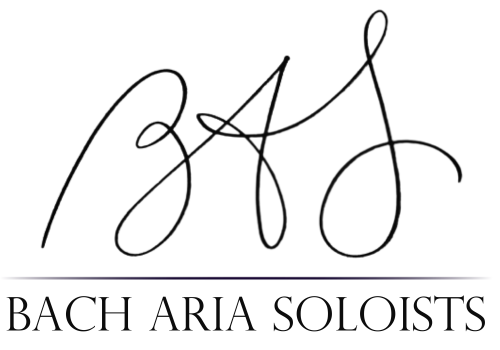Bach Aria Soloists Charm in Notes & Letters
Without fail, the Bach Aria Soloists’ “Notes & Letters” program is a charming offering to the concert season. The ensemble excels at creating welcoming, intimate events and, even in these times of distancing (physical and virtual), the group delivered such a concert.
Recorded at the 1900 Building’s Parkway Room and viewable as a live stream on YouTube, the concert was a fine example of what is possible during these challenging times, with good audio quality, multiple camera angles, a lively, sophisticated program, and excellent performances. Special mention to videographer Larry Brewer, Ian Corbett on sound, and Pat Knutson on lighting, translating the live performance for digital enjoyment.
With music selections bookended by writings of the composers themselves, the concert invited the audience to learn more of the inner workings and emotional details of these revered artists. This concept moves beyond the realm of untouchable, unknowable genius for a glimpse of the personality behind the score, illuminated by their chamber work.
With a brief greeting from violinist and BAS founder Elizabeth Suh Lane, the concert was a sprightly journey, carried along with pleasant performances from actors Justin Barron and Alisa Lynn.
Barron, adorned in a floppy white “poet” shirt, affected a zealous German accent of exaggerated “vees” as Herr Wolfgang Amadeus Mozart, seated at a desk with a candle and quill, first writing to his wife with a naughty, playful tone, then more serious, writing to his ill father, as a sensitive, devoted son.
Sora Park, at the piano, played a soft, sweet melody while Barron gave his tender, silly portrayal, though the rather abrupt end, as Barron left the stage, was awkward.
Suh Lane and cellist Hannah Collins joined Park for the Allegro from Mozart’s Piano Trio in G major. Not only was it a lovely performance, but the ensemble was well-attuned, despite setting up so that they could stay the recommended 6 feet from each other. Balanced, too, were Mozart’s robust statements and delicate lines, rolling one into the other, nicely executed by the trio.
All the participants wore masks throughout the performances, with the exception of the actor on stage. Nevertheless, because of the capability of camera close ups, even though it was only the top half of their faces, the audience was able to observe the musicians’ expressions more closely than if we had been scattered around a performance space.
Swift “scene changes” moved from music to prose, with musicians exiting in one direction after the music and Barron coming from the other direction to center stage. For this portion, he’d added a frightful powdered wig as he spoke from the perspective of Carl Philipp Emanuel Bach, writing of his late father, Johann Sebastian Bach. Despite the ridiculous headgear, the oration was thoughtful and heartfelt, transitioning to Suh Lane, alone in spotlight, performing a mournful Adagio from the Sonata No. 1 in G moll.
This Bach section gave each musician a solo opportunity, with Park giving a deft and confident performance on the somber Fugue No. 16 in g minor, and Collins in the lively Gigue from Suite No. 3 in C major, giving us a different aspect of Bach’s personality, and performed with exquisite phrasing.
Barron, now in cardigan, was Paul Hindemith of 1934. His Hindemith-voice had a strident timbre, peeved and complaining in his letter. Collins, on cello, played a few movements from Sonata op. 25, no. 3. The first was an aptly aggressive, disjointed piece, strident to match, yet giving a lovely last tone whose resonance translated into the digital space. Hindemith’s next excerpt was a chatty note with gossipy asides and bits of news, including a gruesome description of his fingers after performing too long, followed by a softer toned, bouncy work that seemed to nod its head in sympathy. In the final matching, Hindemith bemoaned having to write propaganda and raged against the way his music was presented to the public, with Collins leaping with intensity from the low end of the instrument to the high, with almost martial rhythms.
Alise Lynn declined an accent for reading the letters of a young Clara Wieck to her future husband Robert Schumann, sweet, flippant, teenage words, referencing her compositions between lines showing concerns for Robert’s health. Suh Lane and Park performed the first movement from her Drei Romanzen, a moving, pensive piece.
Lastly, Barron, now as a young Johannes Brahms, joined Lynn for the final spoken segment, roughly outlining their deep friendship and respect. Their separate lines became an almost conversation. The companion piece, the Allegro con brio from Brahms’ Trio in B major, was a fitting finale to this creative, intriguing program, the three musicians in conversation through snippets that questioned and answered, melodies of long scrolling thought, and marked notes accented as though declaimed.
While this set up for digital, distanced performance is not ideal, Bach Aria Soloists, their guests and crew, demonstrated a way forward for creating a concert experience that was enjoyable, accessible, and safe. Virtual access may even be something to consider once in-person concerts are viable again. As the artists quietly made their bows, the chat sidebar filled with enthusiastic comments, thunderous virtual applause.
Concert reviewed Sunday, November 15, 2020.
This article was written by Libby Hanssen and originally appeared in KC Studio.

